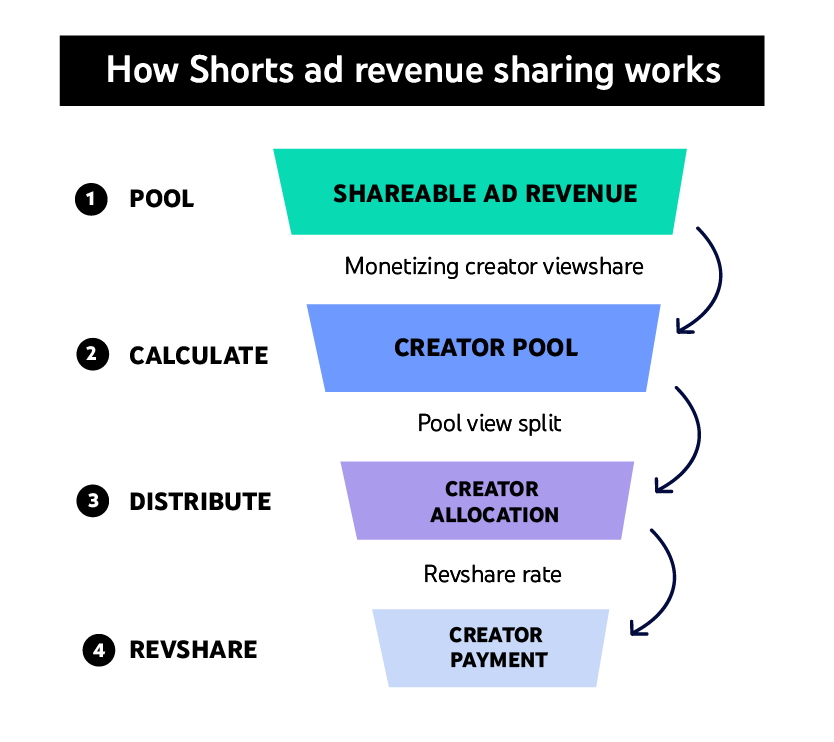YouTube said Monday that revenue sharing will begin for creators of YouTube Shorts Feb. 1, enabling them to earn money from ads viewed between videos in the Shorts feed.
The Google-owned video platform said the new revenue sharing plan replaces the YouTube Shorts Fund, and creators and their channels must follow the platform’s policies on channel monetization, community guidelines, copyright, Google AdSense program, repetitious/reused content and terms of service.
Monetizing partners must accept the Shorts Monetization Module to be eligible for revenue sharing, and those who do so after Feb. 1 will have revenue sharing applied to their eligible Shorts views starting on the date they accept.
YouTube provided the following examples of Shorts views that are ineligible for monetization:
- Non-original content, such as unedited clips from movies or television shows, reuploads of content from other creators on YouTube or other platforms, or compilations with no original content.
- Artificial or fake views, such as those generated by automated click or scroll bots.
- Views that are inconsistent with the platform’s advertising-friendly content guidelines.
The company outlined four steps explaining the revenue-sharing process:
- Pool Shorts feed ad revenue: Each month, revenue from ads running between videos in the Shorts Feed gets added together and used to both reward creators and help cover costs of music licensing.
- Calculate the creator pool: Shorts feed ad revenue is then allocated into the creator pool based on views and music usage across Shorts uploaded by monetizing creators.
- If a monetizing creator uploads a Short without any music, all of the revenue associated with its views goes into the creator pool.
- If a monetizing creator uploads a Short with music in it, YouTube will split the revenue associated with its views between the creator pool and music partners based on the number of tracks used. YouTube explained, “For example, if a monetizing creator uploads a Short with one track, one-half of the revenue associated with its views would be allocated to the creator pool, and the other half would be used to cover the costs of music licensing. If the Short features two music tracks, then one third of the revenue associated with its views would be allocated to the creator pool, with the other two-thirds used to cover the costs of music licensing.”

Revenue from the creator pool will be distributed to monetizing creators based on their share of total views from monetizing creators’ Shorts in each country, with YouTube providing the example that if a creator gets 5% of all eligible Shorts views uploaded by monetizing creators, that creator will be allocated 5% of the revenue in the pool.
Monetizing creators will keep 45% of their allocated revenue, regardless if music was used or not.
The platform’s creator pool does not include:
- Revenue associated with views of Shorts uploaded by creators who haven’t yet accepted the Shorts Monetization Module or aren’t yet eligible to monetize their Shorts. This revenue will be used to cover the costs of music licensing and/or be retained by YouTube.
- Revenue associated with views of Shorts uploaded by music partners.
- Revenue associated with views of Shorts that are determined to be ineligible.
- Revenue associated with any ads shown upon opening the Shorts feed before a Short is viewed, such as the YouTube Shorts Masthead.
- Revenue associated with any ads shown on navigational pages within the Shorts player.
YouTube broke it out further with this hypothetical example: “As a monetizing creator, let’s say you upload a Short that uses one music track. Here’s how we’d calculate what your Short earns in country A this month. There are 100 million total Shorts views in country A, and all views are on Shorts uploaded by monetizing creators. $100,000 is earned from ads that play between Shorts in the Shorts feed. 20% of these Shorts use one music track, so the creator pool is $90,000, and $10,000 is used to cover the costs of music licensing. Your Short is viewed 1 million times, so you are allocated 1% of the creator pool, or $900. Your allocation from the creator pool is not affected by your use of a music track. The 45% revenue share is then applied to your allocation, and you earn $405 for your Shorts views in country A.”
The company will pay 45% of the net revenue from YouTube Premium—its paid subscription option, which enables users to enjoy ad-free content, background playback, downloads and premium access to the YouTube Music application—with a portion of YouTube Premium revenues allocated to help cover costs of music licensing.
Daily Shorts feed ad revenue and other performance metrics will be available via YouTube Analytics on Feb. 1 or the day a creator begins monetizing.
Existing timelines for payment thresholds and other AdSense for YouTube details apply.
Finally, downloadable reports will be available for Studio Content Manager users by mid-march, for non-music partners only, with revenue details segmented by date and country/region for any monetizing Shorts uploaded by relevant partners.









